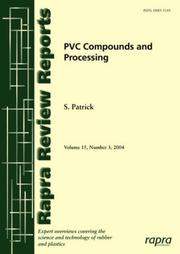| Listing 1 - 2 of 2 |
Sort by
|

ISBN: 1281774596 9786611774592 1847352030 9781847352033 9781859574720 9781847352033 1859574726 9781281774590 6611774599 Year: 2004 Publisher: Shrewsbury, U.K. : Rapra Technology,
Abstract | Keywords | Export | Availability | Bookmark
 Loading...
Loading...Choose an application
- Reference Manager
- EndNote
- RefWorks (Direct export to RefWorks)
The PVC global market size in 2000 was around 25,400 kt. Pipes and fittings constitute the largest volume application at 36% of the marketplace with profiles at 13%. Thus, PVC is one of the most widely used plastics in the world. This overview covers the basics of PVC formulation and processing, while extending the information to include the latest developments in materials and technology. This makes the report accessible and useful to all levels of industry. PVC is of low thermal stability and high melt viscosity. Therefore, it is combined with a number of additives to vary properties to suit
Polyvinyl chloride. --- Polyvinyl chloride --- Polyvinyl chloride industry --- Manufacturing processes. --- Industrial processing --- Manufacture --- Process engineering (Manufactures) --- Processes, Manufacturing --- Processing, Industrial --- Production processes --- Industrial arts --- Production engineering --- Machine-tools --- Materials --- Chemical industry --- Polyvinylchloride --- PVC (Chemical) --- Vinyl chloride polymers --- Health aspects. --- Environmental aspects.
Article
Abstract | Keywords | Export | Availability | Bookmark
 Loading...
Loading...Choose an application
- Reference Manager
- EndNote
- RefWorks (Direct export to RefWorks)
Environmental enrichment (EE) is used in laboratory animal housing to provide stimuli exceeding those of barren cages and is intended to improve the welfare of captive animals. It is argued that when laboratory mice can routinely retreat in sheltering objects when humans are present, they do not habituate to humans and continue to shy away, thereby increasing the time needed for husbandry and testing procedures. To this date very limited research has been carried out to determine whether providing EE in the form of shelter interferes with the habituation of mice to humans and thus complicates catching and handling them. We housed 20 FVB (inbred) and 20 NMRI (outbred) male mice in standard cages and another 20 FVB and 20 NMRI male mice in cages enriched with two PVC conduits. When the mice were 10 weeks old, measurements of food and water consumption, weight, latency of catching, and a behavior score in response to handling during a sham subcutaneous injection were performed weekly for 4 consecutive weeks. Food and water consumption and weight were influenced by strain, but the presence of EE in the home cage did not affect these parameters as much. Outbred mice ate, drank, and weighed more than did the inbred animals, but they did not significantly gain weight during the course of the 4 testing weeks. Cage enrichment in the form of PVC conduits decreased the time needed to catch outbred animals and did not increase the time needed to catch mice from the inbred strain. Furthermore, no differences in resistance to being held during the sham injection could be detected between animals from the enriched versus non-enriched group. These results indicate that EE in the form of sheltering objects does not complicate catching or handling mice and that allowing access to enrichment in the laboratory cage, which has been shown to have positive effects on welfare, does not interfere with the management or cost of laboratory animals.
Access. --- Animal. --- Animals. --- Behavior. --- Cage. --- Cost. --- Enriched. --- Enrichment. --- Environmental enrichment. --- Food. --- Group. --- Habituation. --- Handling. --- Housing. --- Human. --- Humans. --- Husbandry. --- Increase. --- Laboratory animals. --- Laboratory mice. --- Laboratory-animals. --- Laboratory. --- Male-mice. --- Male. --- Management. --- Mice. --- Object. --- Objects. --- Old. --- Parameters. --- Pvc. --- Research. --- Resistance. --- Response. --- Shelter. --- Stimuli. --- Time. --- Weight. --- Welfare.
| Listing 1 - 2 of 2 |
Sort by
|

 Search
Search Feedback
Feedback About UniCat
About UniCat  Help
Help News
News